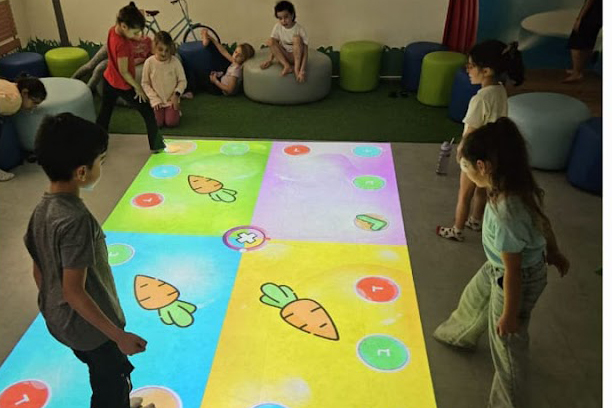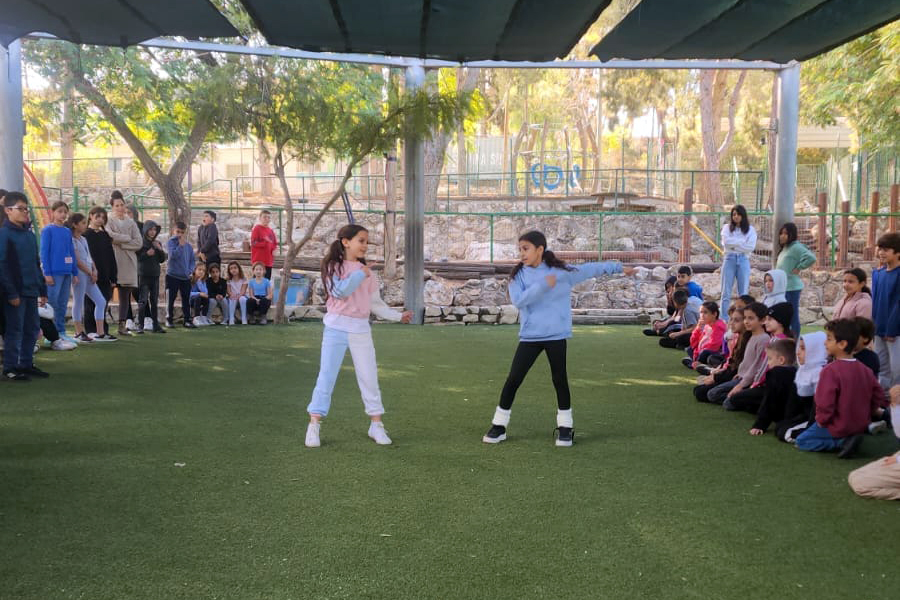Once the Jewish high holidays are over, the real work of learning together can begin. For the first-graders, that involved jumping (literally) into lessons in the Language Center; starting the “forest” classes that will help them learn self-esteem, collaboration, confidence and love for nature; and learning about olive trees in preparation for the annual olive-picking festival.

The second-graders also put an emphasis on working together with a variety of team and group projects and games over the month, including building a tower out of cardboard. They also each investigated their own first names – the meanings and origins.
The third-grade classes used their HOTAM, Education, Culture, Tradition time to learn about the symbols of the Jewish holidays. For Yom Kippur, they learned the words to the Hebrew song “Ma Evakesh” (What will I ask for?) by Eli Revach, leading to a discussion on prayers that ask for the common good versus those that are for personal gain. They also learned about the symbols associated with Sukkot and helped to decorate the school Sukkah.

The third-grade class also planted a new garden on the school grounds, and they learned about the concept of respect, creating art to show how, when one respects others, the result is a vibrant “tree” with leaves of many colors. Language is an important part of their school week, and in Arabic lessons, they worked on their vocabulary, using new words in sentences.
The fourth-graders learned about the holidays of all three religions that fall in the months of September and October: the Jewish High Holidays, the birth of the Prophet Muhammed and the Feast of the Cross. To enjoy what they had learned, the kids set a festive table with apples and honey and other holiday symbols. The native Hebrew speakers learned about the months in a section on “beginnings and cycles.” They learned the order of the Hebrew months and the phases of the moon, and how the Hebrew months are based on the lunar cycle.

To learn geometry, the kids went outdoors. The lesson on diagonals and rhombuses started off with a long length of string and kids standing at the corners of the shapes they made. By moving, they could change the angles and lengths of the sides, and by adding further string, they could investigate the diagonals that intersect the shapes. As this activity required the participation of the entire class, it ended up building class cohesion along with their math lesson. The third graders had further class-building session led by a trainer, meant to build ties with their teaching staff as well as with one another.
The fifth-graders combined the HOTAM subject “beginnings and cycles” with their Hebrew lessons to enrich their vocabulary and understanding of grammar. They also conducted a section on olive trees, investigating their importance and their various uses. As they days remained sunny, they organized games in the school yard at recess.

For the sixth-graders, beginnings and cycles took on new meaning as they read poems and gathered information on the yearly cycles, as well as reading the Book of Jonah, which led to a discussion on the meaning of forgiveness. To top off the section, the classes put on skits with read material, and they worked on the idea of presenting information in a way that is comprehensible and accessible. They also celebrated the Tishri holidays by picking cards with sayings that spoke to them, personally, and explaining why to the class.
The sixth-graders were excited to start working with the second-grade class as “big brothers and sisters.” They began the project by playing an ice-breaker game together.

Olive picking: The annual olive-picking festival was delayed this year due to the war, but it did finally take place at the beginning of November. The sixth-graders took responsibility for setting up the stations, and the kids had an opportunity to pick the fruit of these trees, which are a symbol of peace, and to share the knowledge they had gained in the classroom and from their investigations of these amazing trees. The parents came to help, and the entire event reminded families and children that the secret to living with one another involves sharing and enjoying feasts together.

Light and lighting the way: The fourth graders took on the opening of the next HOTAM subject: Light and Lighting the Way. To do so, they became “ambassadors” for “illuminating the path through cooperation,” going around to the other classrooms to talk about light. Just as the light of a fire, electricity or the sun is necessary to humanity, we also require the light of our society and of living in a shared society with justice for all. The ambassadors were well received, giving the fourth graders new confidence in their communications skills and in their ability to work together as a group.

The primary school’s got talent: Children who participate in the extra-curricular program with Yohai put on a talent show for the rest of the school. They treated the school to a variety show with music, song, dance and gymnastics, and took their bows to wild applause.






